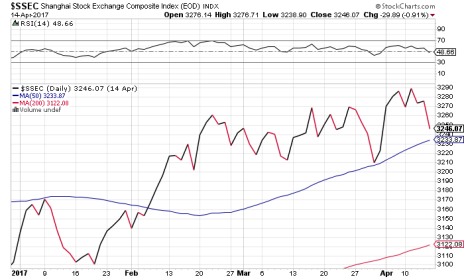On the surface, there was good news for Chinese stocks on Monday: during the first quarter, China’s economy expanded faster than it had in 18 months. The 6.9% GDP growth was the most since the third quarter of 2015, and topped economists’ expectations of 6.5% growth.
Chinese stocks didn’t react much, at least initially. The Shanghai Composite has actually declined for about a week, since hitting a one-year high of 3,288 on April 11. But the index still trades comfortably above its 50-day moving average (as it has for more than two months), and the new economic data could act as a nice tailwind in the weeks to come.
Industrial growth was perhaps the most encouraging part of China’s economic report. The government’s heavy spending on infrastructure and real estate development helped push China’s industrial output in the first quarter to its highest level in more than two years, with housing starts improving roughly 12% in March. Retail sales (10.9% growth) and exports also surged. Even auto sales ticked up in March after a slow first two months of the year.
Those are all positive signs that the Chinese economy has stopped the bleeding, even though all things China economy should be taken with a hefty dose of salt given the government’s frequently outsized role in prettying up that growth. To wit, China’s central and local governments spent 21% more in the first quarter than they did a year ago.
That said, investors tend to focus on the bottom line. And that’s especially true of U.S. investors evaluating emerging market stocks, which is why Chinese ADRs (American depositary receipts), or foreign stocks that also trade on a U.S. market) have outpaced Chinese stocks by nearly four-to-one so far this year. The PowerShares Golden Dragon China ETF (PGJ), which tracks the price of Chinese ADRs, is up 18.3% in 2017, and has been trading above its 50-day line since early January.
Anecdotally, my best indicator about the health of the Chinese stock market is Cabot’s own emerging market investing expert, Paul Goodwin. Right now, Paul recommends six Chinese stocks as Buys in his Cabot Global Stocks Explorer (formerly Cabot Emerging Markets Investor) advisory portfolio; five of the six are currently winners, with an average return of 38%. That’s a pretty good indication that Chinese stocks are in a good place at the moment.
If you want access to Paul’s specific recommendations, for Chinese stocks and other emerging markets stocks, you can subscribe to his advisory by clicking here. His portfolio, comprised of 10 stocks all bought within the last 18 months, currently shows an average return of more than 33%.
Less than four months in, 2017 has been a good year to invest in Chinese stocks thus far. After yesterday’s positive economic news, it could get even better.

Sign up now!

Sign up now!

Sign up now!

Sign up now!

